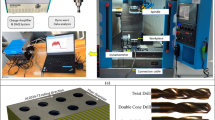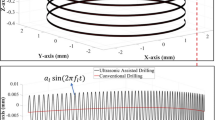Abstract
Ultrasonic-assisted drilling (UAD) is a promising technology used for machining difficult-to-cut materials. In this paper, experimental investigations were conducted to study the drilling forces and edge chipping for soda glass using diamond abrasive tools. Cutting fluid was used at different levels of feed rate, spindle speed, and tool concentrations. The thrust force, torque, and edge chipping parameters (width, depth, and angle) at entrance and exit sides of the drilled holes were evaluated. Statistical analysis was carried out to support the experimental findings, optimize the process responses, and construct the mean effect plots and interactions of the process parameters. The results show that the thrust force increases when using normal tool concentration, lower spindle speeds, and higher feed rates. The normal concentration, low spindle speed, and high feed rate decrease the exit chipping width. The theoretical analysis proves that the chipping force is less than the impact force and they are not correlated.
Similar content being viewed by others
References
Iliescu C, Jing J, Tay FE, Miao J, Sun T (2005) Characterization of masking layers for deep wet etching of glass in an improved HF/HCl solution. Surf Coat Technol 198:314–318. https://doi.org/10.1016/j.surfcoat.2004.10.094
Lin CH, Lee GB, Lin YH, Chang GL (2001) A fast prototyping process for fabrication of microfluidic systems on soda-lime glass. J Micromech Microeng 11:726–732. https://doi.org/10.1088/0960-1317/11/6/316
Ahmed T, Cong WL, Stanco MR, Xu ZG, Pei ZJ, Treadwell C, Zhu YL, Li ZC (2012) Rotary ultrasonic machining of alumina dental ceramics: a preliminary experimental study on surface and subsurface damages. J Manuf Sci Eng 134:64501. doi: https://doi.org/10.1115/1.4007711
Wang J, Feng P, Zhang J, Zhang C, Pei Z (2016) Modeling the dependency of edge chipping size on the material properties and cutting force for rotary ultrasonic drilling of brittle materials. Int J Mach Tools Manuf 101:18–27. https://doi.org/10.1016/j.ijmachtools.2015.10.005
Moriwaki T, Shamoto E, Inoue K (1992) Ultraprecision ductile cutting of glass by applying ultrasonic vibration. CIRP Ann Manuf Technol 41:141–144. https://doi.org/10.1016/S0007-8506(07)61171-8
Zhou M, Liu XD, Huang SN (2007) Ultraprecision ductile-regime cutting of brittle materials. Key Eng Mater 339:395–399. https://doi.org/10.4028/www.scientific.net/KEM.339.395
Asami T, Miura H (2013) Characteristics of ultrasonic complex vibration for hole machining in brittle materials: comparison of longitudinal and complex vibration sources. 19:030113. https://doi.org/10.1121/1.4799094
Asami T, Miura H (2012) Characteristics of hole machining of brittle material by ultrasonic complex vibration. Jpn J Appl Phys 51:07GE07
Asami T, Miura H (2015) Study of ultrasonic machining by longitudinal-torsional vibration for processing brittle materials-observation of machining marks. Phys Procedia 70:118–121. https://doi.org/10.1016/j.phpro.2015.08.056
Wang J, Shimada K, Mizutani M, Kuriyagawa T (2014) Using smoothed particle hydrodynamics to examine influence of process parameters on ultrasonic machining. Int J Autom Technol 8:855–763. https://doi.org/10.20965/ijat.2014.p0855
El-Taybany Y, Hossam M, El-Hofy H (2017) Experimental investigation of ultrasonic-assisted milling of soda glass using factorial design of experiments. Procedia CIRP 58:381–386. https://doi.org/10.1016/j.procir.2017.03.238
Wu J, Cong W, Williams RE, Pei ZJ (2011) Dynamic process modeling for rotary ultrasonic machining of alumina. J Manuf Sci Eng 133:41012. https://doi.org/10.1115/1.4004688
Zhang C, Cong W, Feng P, Pei Z (2013) Rotary ultrasonic machining of optical K9 glass using compressed air as coolant: a feasibility study. Proc Inst Mech Eng B J Eng Manuf 228:504–514. https://doi.org/10.1177/0954405413506195
Ding K, Fu Y, Su H, Chen Y, Yu X, Ding G (2014) Experimental studies on drilling tool load and machining quality of C/SiC composites in rotary ultrasonic machining. J Mater Process Technol 214:2900–2907. https://doi.org/10.1016/j.jmatprotec.2014.06.015
Ning FD, Cong WL, Pei ZJ, Treadwell C (2016) Rotary ultrasonic machining of CFRP: a comparison with grinding. Ultrasonics 66:125–132. https://doi.org/10.1016/j.ultras.2015.11.002
Makhdum F, Phadnis VA, Roy A, Silberschmidt VV (2014) Effect of ultrasonically-assisted drilling on carbon-fibre-reinforced plastics. J Sound Vib 333:5939–5952. https://doi.org/10.1016/j.jsv.2014.05.042
Wang J, Zha H, Feng P, Zhang J (2015) On the mechanism of edge chipping reduction in rotary ultrasonic drilling: a novel experimental method. Precis Eng 44:231–235. https://doi.org/10.1016/j.precisioneng.2015.12.008
Wang J, Feng P, Zhang J (2016) Reduction of edge chipping in rotary ultrasonic machining by using step drill: a feasibility study. Int J Adv Manuf Technol 87:1–11. https://doi.org/10.1007/s00170-016-8655-8
Wang J, Feng P, Zheng J, Zhang J (2016) Improving hole exit quality in rotary ultrasonic machining of ceramic matrix composites using a compound step-taper drill. Ceram Int 42:13387–13394. https://doi.org/10.1016/j.ceramint.2016.05.095
Lv D, Zhang Y, Peng Y (2016) High-frequency vibration effects on hole entrance chipping in rotary ultrasonic drilling of BK7 glass. Ultrasonics 72:47–56. https://doi.org/10.1016/j.ultras.2016.07.011
Zhang CL, Feng PF, Wu ZJ, Yu DW (2012) A mathematical model for predicting cutting force in rotary ultrasonic drilling. Adv Mater Res 433–440:2034–2041. https://doi.org/10.4028/www.scientific.net/AMR.433-440.2034
Bifano TG, Dow TA, Scattergood RO (1991) Ductile-regime grinding: a new technology for machining brittle materials. J Eng Ind 113:184. https://doi.org/10.1115/1.2899676
Liu D, Cong WL, Pei ZJ, Tang Y (2012) A cutting force model for rotary ultrasonic machining of brittle materials. Int J Mach Tools Manuf 52:77–84. https://doi.org/10.1016/j.ijmachtools.2011.09.006
Atkinson C, Martinez-Esnaola JM, Elizalde MR (2012) Contact mechanics: a review and some applications. Mater Sci Technol 28:1079–1091. https://doi.org/10.1179/1743284711Y.0000000123
Chai H (2015) On edge chipping in cylindrical surfaces. Int J Solids Struct 54:12–19. https://doi.org/10.1016/j.ijsolstr.2014.11.014
Pei ZJ, Prabhakar D, Ferreira PM, Haselkorn M (1995) A mechanistic approach to the prediction of material removal rates in rotary ultrasonic machining. J Eng Ind 117(2):142. https://doi.org/10.1115/1.2803288
Qin N, Pei ZJ, Treadwell C, Guo DM (2009) Physics-based predictive cutting force model in ultrasonic-vibration-assisted grinding for titanium drilling. J Manuf Sci Eng 131:41011. https://doi.org/10.1115/1.3159050
Yuan S, Zhang C, Amin C, Fan H, Liu M (2015) Development of a cutting force prediction model based on brittle fracture for carbon fiber reinforced polymers for rotary ultrasonic drilling. Int J Adv Manuf Technol 81:1223–1231. https://doi.org/10.1007/s00170-015-7269-x
Funding
This research work is sponsored by the Egyptian Ministry of Higher Education (MoHE) grant and the Japanese International Cooperation Agency (JICA) in the scope of the Egypt-Japan University of Science and Technology.
Author information
Authors and Affiliations
Corresponding author
Rights and permissions
About this article
Cite this article
Abdelkawy, A., Hossam, M. & El-Hofy, H. Experimental investigation of the cutting forces and edge chipping in ultrasonic-assisted drilling of soda glass. Int J Adv Manuf Technol 100, 1433–1449 (2019). https://doi.org/10.1007/s00170-018-2771-6
Received:
Accepted:
Published:
Issue Date:
DOI: https://doi.org/10.1007/s00170-018-2771-6




